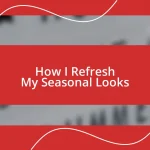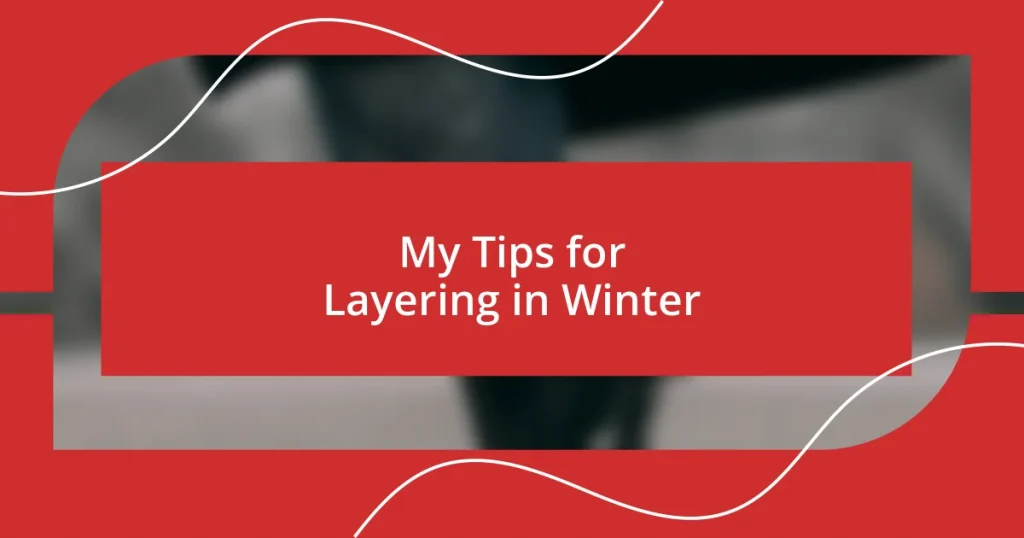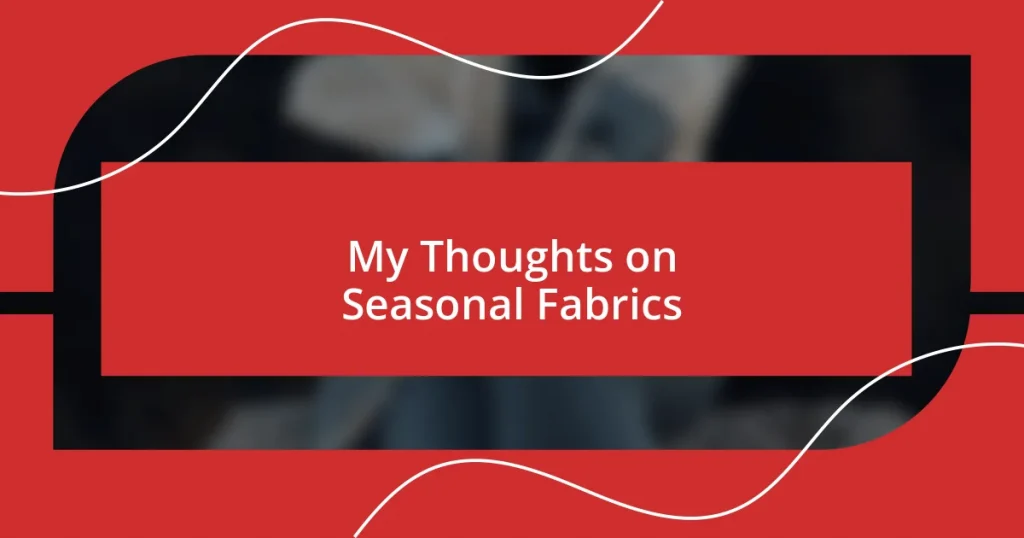Key takeaways:
- Understanding seasonal color theory can transform personal style and boost confidence by highlighting colors that resonate with an individual’s personality.
- Identifying personal seasons involves examining undertones, emotional reactions to colors, and wardrobe patterns, leading to deeper self-discovery.
- Incorporating seasonal colors into one’s wardrobe can invigorate outfits and moods, with nature often serving as a source of inspiration for color combinations.
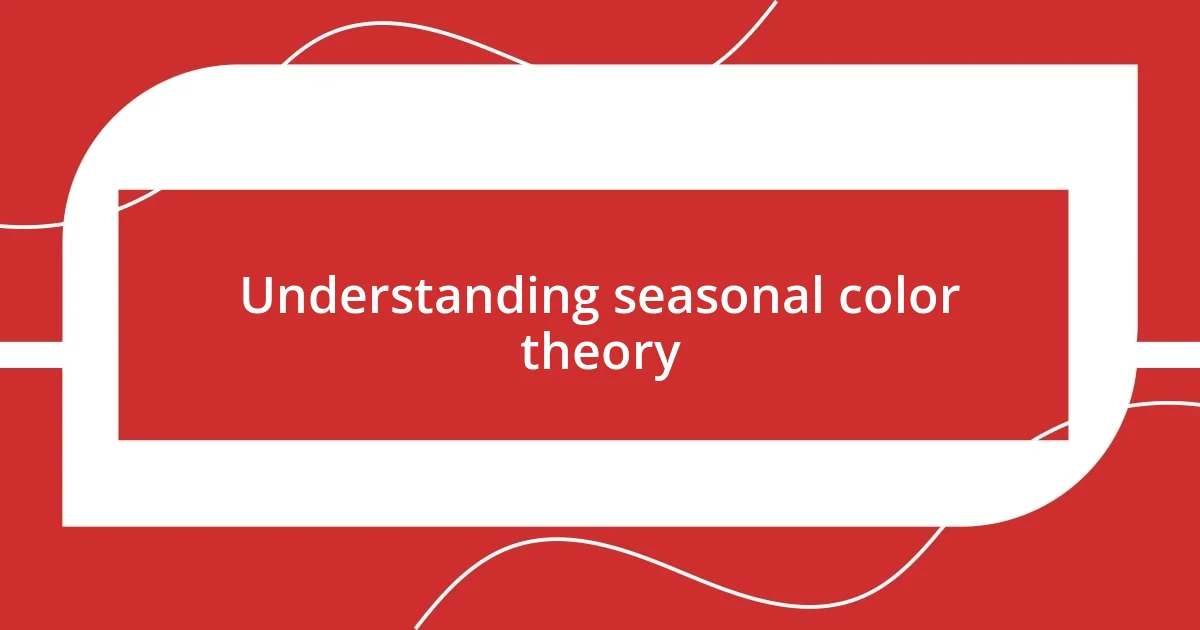
Understanding seasonal color theory
Understanding seasonal color theory is all about recognizing how colors can evoke emotions and influence perceptions about ourselves and our style. I remember the first time I experimented with a seasonal palette; it felt like putting on a new pair of glasses. Suddenly, colors that seemed dull before brought out the vibrancy in my skin tone, and I couldn’t help but wonder, “How had I overlooked these hues for so long?”
When I think of seasonal color theory, I often reflect on the four main categories: Winter, Spring, Summer, and Autumn. Each season embodies unique characteristics—Winter is bold and cool, while Autumn is warm and earthy. This nuanced framework helped me realize that by choosing the right colors, I could showcase the best parts of my personality. Isn’t it fascinating how the right color can make us feel confident, energetic, or even serene?
Exploring my own color palette led to unexpected revelations about my preferences. One day, I wore a bright coral blouse, and a friend commented on how it lit up my face. It made me ponder: “What are the colors that truly resonate with my spirit?” Diving into seasonal color theory not only transformed my wardrobe but also deepened my understanding of how colors reflect our emotional states and individuality.

Identifying your personal season
Identifying your personal season can be a transformative experience. When I first approached this concept, I found it helpful to consider my natural attributes—like my skin tone, hair color, and even the colors that make me feel good. It was surprisingly revealing to realize that I was often drawn to certain shades without fully understanding why.
Here are some tips that helped me pinpoint my personal season:
- Examine Your Undertones: Determine if you have cool (pink or blue) or warm (gold or peach) undertones. This can guide you to the shades that suit you best.
- Observe Your Reactions: Pay attention to which colors elicit positive emotions. I remember wearing a soft lavender sweater and feeling instantly uplifted.
- Test with Fabrics: Try draping different colors around your face to see which ones brighten your complexion or enhance your features. I was amazed at how a dusty rose instantly lit up my eyes while a stark white drained my energy.
- Assess Your Wardrobe: Look at the colors you naturally gravitate toward in your closet. Reflecting on this helped me see patterns that aligned with my season.
Through this exploration, I’ve discovered that finding my season isn’t just about aesthetics; it’s about understanding my connection to color and how it shapes my identity. Each hue has a story that resonates with different facets of who I am—a beautiful journey of self-discovery.
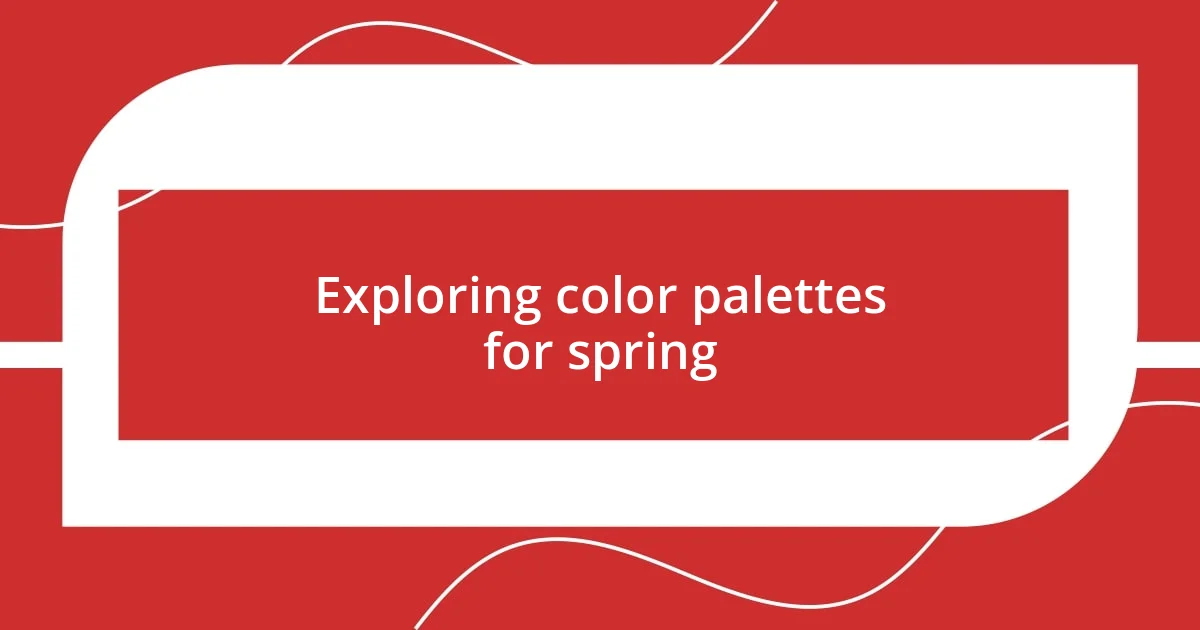
Exploring color palettes for spring
Exploring color palettes for spring is a joyful experience, full of vibrancy and hope. I remember the first time I embraced the soft pastels and lively colors usually associated with this season. I slipped into a mint green dress, and it felt as if I had welcomed spring into my wardrobe. The lightness of the fabric and the cheerful hue instantly lifted my mood, making me feel more energetic and ready to take on the day.
As I delved deeper into spring palettes, I began to notice how certain colors interacted with my skin tone. Shades like peach and soft lavender unexpectedly complemented my complexion, while bright yellows added an exciting pop. I often think of color as a form of expression; for instance, wearing a pastel pink top felt like wrapping myself in warmth and kindness. It’s fascinating how these colors can shift our emotions and enhance how we present ourselves to the world.
To get a better grasp of how these spring shades work, here’s a comparative look at some common spring color palettes. I find it incredibly useful to see the nuances between similar tones, as it helps clarify which colors truly resonate with me.
| Color Palette | Description |
|---|---|
| Soft Pastels | Delicate hues like baby blue, soft pink, and lavender create a gentle, refreshing vibe. |
| Vibrant Florals | Bright colors such as coral, sunny yellow, and turquoise mimic the lively blooms of spring, energizing our presence. |
| Earthy Neutrals | Soft browns and muted greens reflect nature’s awakening, grounding us while still embracing spring’s spirit. |

Exploring color palettes for summer
Exploring color palettes for summer opens up a whole new world of vivid, warm hues that capture the essence of the season. I remember experimenting with fiery oranges and sunny yellows, each piece bringing to mind images of beach vacations and sunlit picnics. The first time I wore a bright coral sundress, it felt like I was stepping into summer itself, radiating warmth and a sense of joy that was almost contagious.
As I embraced summer shades, I found myself drawn to the refreshing tranquility of ocean blues and greens. The moment I slipped into a soft teal top, it was as if a gentle breeze swept over me, instantly lifting my spirits. Have you ever noticed how certain colors can evoke memories or emotions? That teal took me back to happy summer days spent by the sea, reminding me of the carefree vibes that accompany those warm months.
I also discovered that summer palettes can be surprisingly versatile. For instance, pairing a bold magenta with crisp white creates a stunning contrast that feels both fresh and stylish. It’s fascinating to play around with combinations that enhance my summer glow while telling a story. Think about your own experiences—what colors make you feel the most alive during this vibrant season? Each time I layer different shades, I feel like I’m painting my own summer adventure, one outfit at a time.
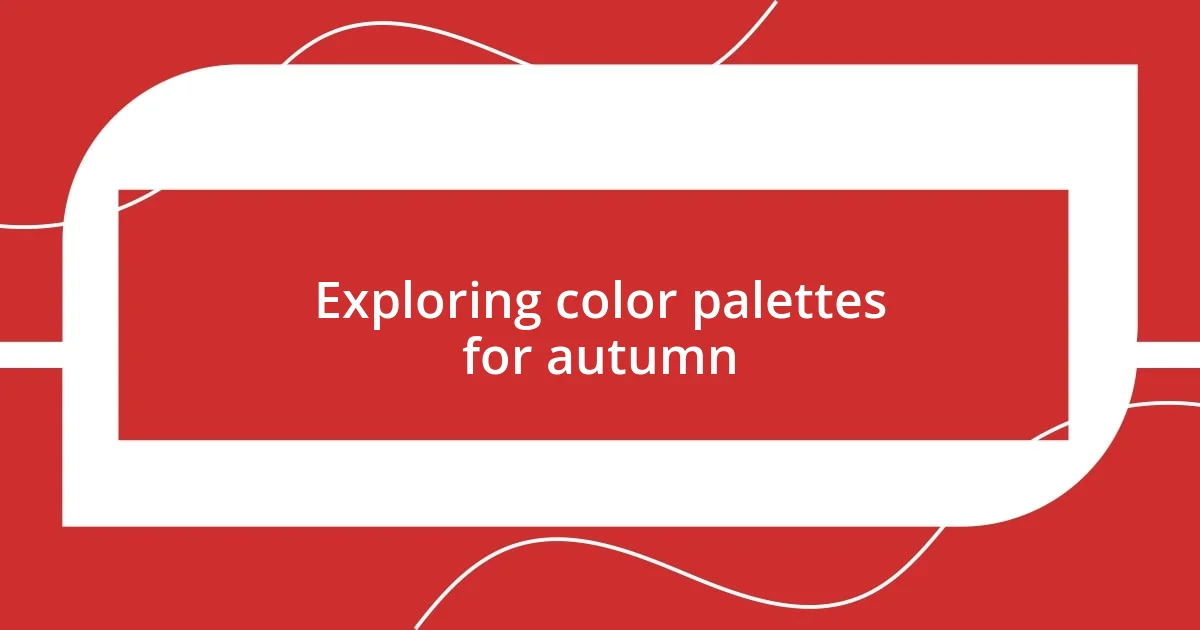
Exploring color palettes for autumn
As I explore color palettes for autumn, I can’t help but be enchanted by the rich, earthy tones that begin to emerge. Picture this: I remember the first time I donned a deep burgundy sweater; it enveloped me like a warm hug on a chilly day. The color seemed to echo the changing leaves, creating a sense of harmony with the season.
This time of year always pulls me toward warm browns, burnt oranges, and mustard yellows, embracing the cozy spirit of fall. I often think about how these colors resonate with our emotions—there’s something about slipping into a pumpkin-spiced cardigan that feels incredibly inviting. Isn’t it amazing how a color can evoke such comfort and nostalgia, reminding us of fall festivals and family gatherings?
When I mix these autumn shades, I often opt for layering. I vividly recall pairing a golden yellow scarf with a rust-colored jacket last year; the combination made me feel vibrant yet grounded. Each tone tells its own story, and I enjoy weaving them together, creating a tapestry of warmth that reflects the beauty of this transitional season.
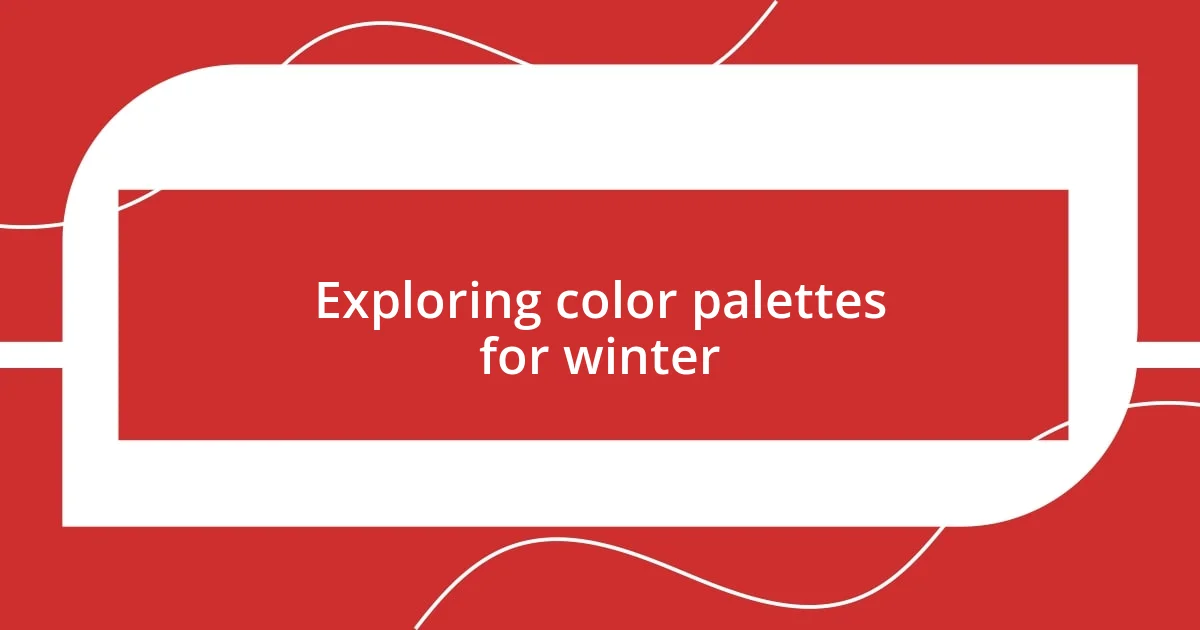
Exploring color palettes for winter
As winter settles in, I get excited about the cool, crisp hues that define this season. I fondly recall the first time I experimented with icy blues and soft whites—it’s like being wrapped in a shimmering blanket of fresh snow. There’s something invigorating about wearing these shades; they effortlessly lift my spirits and remind me of the beauty of winter wonderlands.
I find that winter palettes can also benefit from rich jewel tones, such as deep emeralds and royal purples, which add a touch of elegance against the starkness of the season. The first time I paired a plush purple sweater with my black winter coat, I felt like royalty. Isn’t it intriguing how these bold colors can create a striking contrast with the snow-covered landscape? They turn the dull winter days into something vibrant and alive.
Layering becomes a key player as I dive deeper into winter wardrobes. I love combining textures and tones—like a luxurious cashmere scarf in a deep teal draped over a cobalt blue coat. Each layer adds depth and warmth, creating that cozy, inviting look I crave during those chilly months. Have you ever noticed how winter outfits can transform your mood? For me, it’s the perfect blend of comfort and style that keeps me looking forward to the chilly adventures ahead.
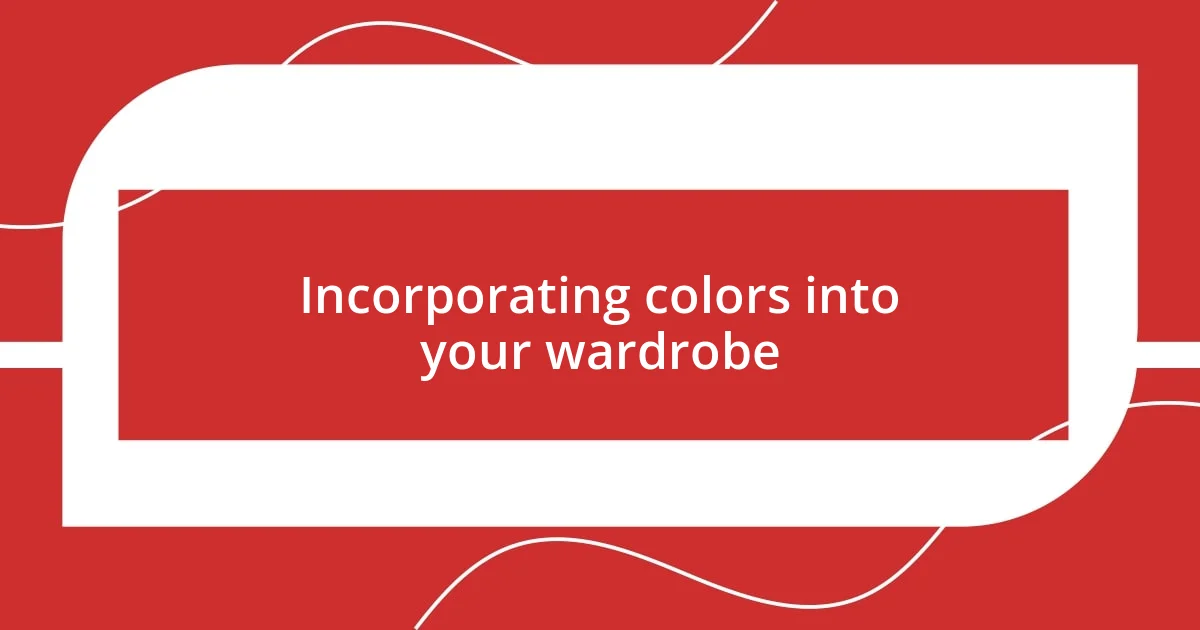
Incorporating colors into your wardrobe
Incorporating colors into my wardrobe is an evolving art that constantly excites me. I remember a few years back when I decided to brighten my winter blues with a vivid coral blouse. When I wore it with some classic black trousers, I felt an instant boost in my energy. Isn’t it interesting how a pop of color can transform an outfit—and even your mood?
As I explore new color combinations, I often experiment with accessories. I once added a bold turquoise handbag to my otherwise neutral outfit. The striking contrast made a mundane day suddenly feel festive, and I couldn’t help but smile every time I caught a glimpse of it. Have you ever noticed how a simple accessory can breathe new life into your wardrobe?
Sometimes, I find inspiration in nature. On a recent walk, I saw trees adorned with vibrant autumn leaves, which prompted me to reimagine my own color choices. I paired a deep green top with a pair of khaki pants, mimicking those earthy tones I admired outside. It’s amazing how pulling colors from your surroundings can create a harmonious, cohesive look that feels both fresh and personally connected. What colors have you drawn inspiration from lately?








